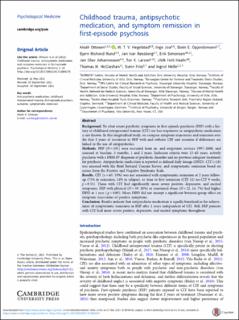| dc.contributor.author | Ottesen, Akiah | |
| dc.contributor.author | Hegelstad, Wenche | |
| dc.contributor.author | Joa, Inge | |
| dc.contributor.author | Ilner, Stein E. Opjordsmoen | |
| dc.contributor.author | Rund, Bjørn Rishovd | |
| dc.contributor.author | Røssberg, Jan Ivar | |
| dc.contributor.author | Simonsen, Erik | |
| dc.contributor.author | Johannessen, Jan Olav | |
| dc.contributor.author | Larsen, Tor Ketil | |
| dc.contributor.author | Haahr, Ulrik H. | |
| dc.contributor.author | McGlashan, T.H. | |
| dc.contributor.author | Friis, Svein | |
| dc.contributor.author | Melle, Ingrid | |
| dc.date.accessioned | 2021-12-02T11:41:53Z | |
| dc.date.available | 2021-12-02T11:41:53Z | |
| dc.date.created | 2021-11-30T09:35:16Z | |
| dc.date.issued | 2021-11 | |
| dc.identifier.citation | Ottesen, A., Hegelstad, W.T.V., Joa, I. et al. (2021) Childhood trauma, antipsychotic medication, and symptom remission in first-episode psychosis. Psychological Medicine, 1-10 | en_US |
| dc.identifier.issn | 0033-2917 | |
| dc.identifier.uri | https://hdl.handle.net/11250/2832555 | |
| dc.description.abstract | Background
To what extent psychotic symptoms in first-episode psychosis (FEP) with a history of childhood interpersonal trauma (CIT) are less responsive to antipsychotic medication is not known. In this longitudinal study, we compare symptom trajectories and remission over the first 2 years of treatment in FEP with and without CIT and examine if differences are linked to the use of antipsychotics.
Methods
FEP (N = 191) were recruited from in- and outpatient services 1997–2000, and assessed at baseline, 3 months, 1 and 2 years. Inclusion criteria were 15–65 years, actively psychotic with a DSM-IV diagnosis of psychotic disorder and no previous adequate treatment for psychosis. Antipsychotic medication is reported as defined daily dosage (DDD). CIT (<18) was assessed with the Brief Betrayal Trauma Survey, and symptomatic remission based on scores from the Positive and Negative Syndrome Scale.
Results
CIT (n = 63, 33%) was not associated with symptomatic remission at 2 years follow-up (71% in remission, 14% in relapse), or time to first remission (CIT 12/ no-CIT 9 weeks, p = 0.51). Those with CIT had significantly more severe positive, depressive, and excited symptoms. FEP with physical (N = 39, 20%) or emotional abuse (N = 22, 14, 7%) had higher DDD at 1 year (p < 0.05). Mean DDD did not excerpt a significant between-group effect on symptom trajectories of positive symptoms.
Conclusion
Results indicate that antipsychotic medication is equally beneficial in the achievement of symptomatic remission in FEP after 2 years independent of CIT. Still, FEP patients with CIT had more severe positive, depressive, and excited symptoms throughout. | en_US |
| dc.language.iso | eng | en_US |
| dc.publisher | Cambridge University Press | en_US |
| dc.rights | Navngivelse 4.0 Internasjonal | * |
| dc.rights.uri | http://creativecommons.org/licenses/by/4.0/deed.no | * |
| dc.subject | psykiatri | en_US |
| dc.subject | psykose | en_US |
| dc.subject | antipsykotika | en_US |
| dc.subject | barndomstraume | en_US |
| dc.subject | symptomatisk remisjon | en_US |
| dc.title | Childhood trauma, antipsychotic medication, and symptom remission in first-episode psychosis | en_US |
| dc.type | Peer reviewed | en_US |
| dc.type | Journal article | en_US |
| dc.description.version | publishedVersion | en_US |
| dc.rights.holder | © The Author(s) 2021 | en_US |
| dc.subject.nsi | VDP::Medisinske Fag: 700::Klinisk medisinske fag: 750::Psykiatri, barnepsykiatri: 757 | en_US |
| dc.source.pagenumber | 1-10 | en_US |
| dc.source.journal | Psychological Medicine | en_US |
| dc.identifier.doi | 10.1017/S003329172100427X | |
| dc.identifier.cristin | 1961387 | |
| cristin.ispublished | true | |
| cristin.fulltext | original | |
| cristin.qualitycode | 2 | |

